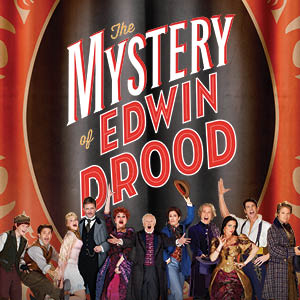I once did a book report on The Mystery of Edwin Drood in 8th grade because I procrastinated and it seemed like a good idea at the time. Frankly, I don’t remember much, except that the book was unfinished and I got a good grade. While I haven’t picked up the book since, the novel by Charles Dickens caught my attention once again when I discovered Rupert Holmes’ unique musical adaptation. Since Dickens died leaving half the book unwritten – and leaving no authoritative record of “who did it” – Holmes created a novel concept of having the audience vote to determine the show’s ending. (The original production’s tagline was “The Solve-It-Yourself Broadway Musical”).
The musical, also known as just Drood (or as I like to call it, Murder She Drood), is presented as an English music hall with actors playing a Victorian troupe performing the Dickens novel, led by a Chairman (a master of ceremonies, of sorts) to help keep the audience informed of facts, and to keep the show running as smoothly as possible. The knowing metatheatrical nature and general rollicking frivolity behind Holmes’ concept made the show a success at the Delacorte in Central Park, as well as its Tony-winning run at the Imperial.
The musical is back on Broadway, courtesy of Roundabout Theatre, with a wonderful cast headlined by the legendary Chita Rivera at Studio 54. While I didn’t love this production as much as many others have, I had a good time, especially with a stellar cast to help gloss over some of the problematic elements of the piece.
The resulting show is something of a joyous mess. The score is filled with music hall style turns, tuneful and entertaining. There are too many songs (about a half dozen could easily be cut), and not enough plot, and Dickens’ novel ultimately becomes an afterthought in this theatrical exercise. However, it is the execution of the concept and the free-for-all voting experience that makes the show a pleasant divertissement.
The legendary Chita Rivera is game but not quite right for the Princess Puffer, with a Cockney accent that veers somewhere between Brooklyn and Staten Island. However, she is so mesmerizing onstage, it’s almost impossible to look at anyone else whenever she’s around. Stephanie J. Block is the title character; hilarious and spirited with a voice to last for days – that famed E is no joke.
Will Chase is near-perfect as Jasper, finding the comedy in the split personality (and likeliest murderer) and singing exceptionally well. However, his pronounced breathing between phrases drove me nuts. Jim Norton is the Chairman, charming but surprisingly subdued. Betsy Wolfe is Rosa Bud and scores with the hauntingly beautiful “Moonfall,” (and her Jennifer Tilly-esque delivery of the line “Good one, Helena” should never be forgotten). Peter Benson, Gregg Edelman and Robert Creighton are also on hand to supply some distinctive period comedy flair.
The company mingles with the audience in the moments leading up to the rollicking opening number, but the show lags and doesn’t reach this same pinnacle until after the rousing “Don’t Quit While You’re Ahead” when the narrative ends and the concept takes over. Nevertheless, there is much fun to be had, especially if you just show up for the second act.
For those who are interested, the night I saw the show, Helena Landless (the sublime Jessie Mueller) was voted Dick Datchery, Neville Landless (a game Andy Karl) was voted the murderer, and the Puffer and Bazzard were voted the lovers (made all the more raucous as Rivera, on the eve of her 80th birthday, pushed Peter Benson’s face into her bosom).



